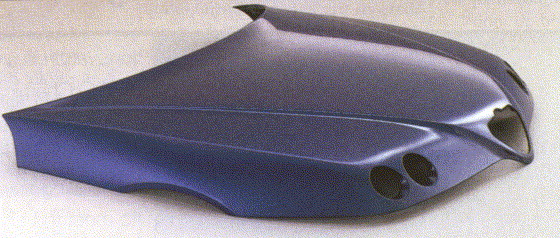To save weight the bonnet was made from a composite material called KMC (composed of polyester and fiberglass, and using epoxi adhesives also), while front wings were made in PUR plastic. At the time, the bonnet was the largest single composite moulding on a production car. When the bonnet is opened, two rectangular Hella headlamps are revealed with separate bulbs for dip and main beam, behind the four round holes in the bonnet.
Among the plastic parts, the front bonnet is highly important which integrates the radiator grille and part of the wheel arches.It is very difficult to make this part in sheet metal because of its particular shape. It was therefore decided to make it in composite material: KMC (Kneaded Molding Compound, material mainly made up of polyester resin and glass fibres).
The bonnet comprises tho parts:
– an outer part (covering) with high aesthetic performance levels (outer surface class A, i.e. appearance equalling that of sheet metal) and levels of plasticity (the obtainable dimensional precision is appr. 0,4 mm of error per metre);
– an inner part (frame) with high structural performance levels (high mechanical strenght and resistance to high temperatures).
The two parts are glued together with a structural Epoxy Bicomponent adhesive obtaining high rigidity and dimensional stability. The composite material with which the bonnet is made contins a high percentage of glass (35%) and compared with sheet metal, it offers a considerable number of advantages.
The more important ones are the following:
– high resistance to shocks and in particular the capability to absorb minor shocks without damage. In fact with a shock of 2Kgm (eg. 1 Kg dropped from a height of 2m) it remains undamaged, whereas sheet metal is damaged;
– it is not subject to corrosion;
– it is easy to repair in the case of breakage.
Bonnet is propped with 2 telescopic nitrogen-filled props and therefore do net require any additional support. The bonnet weights around 30 kg.

